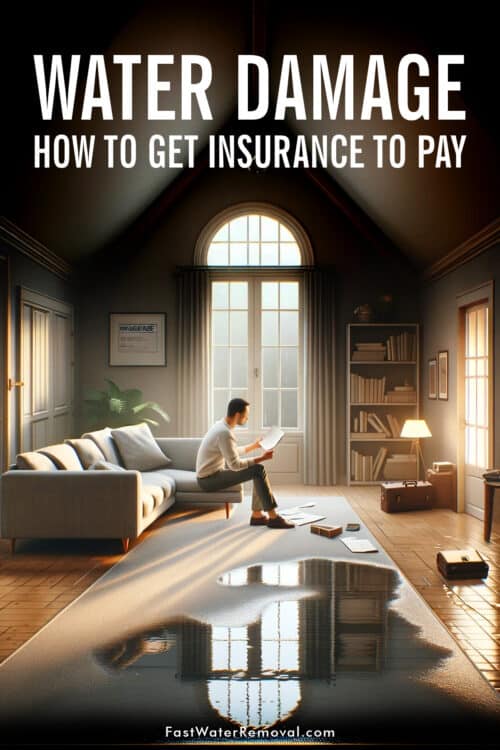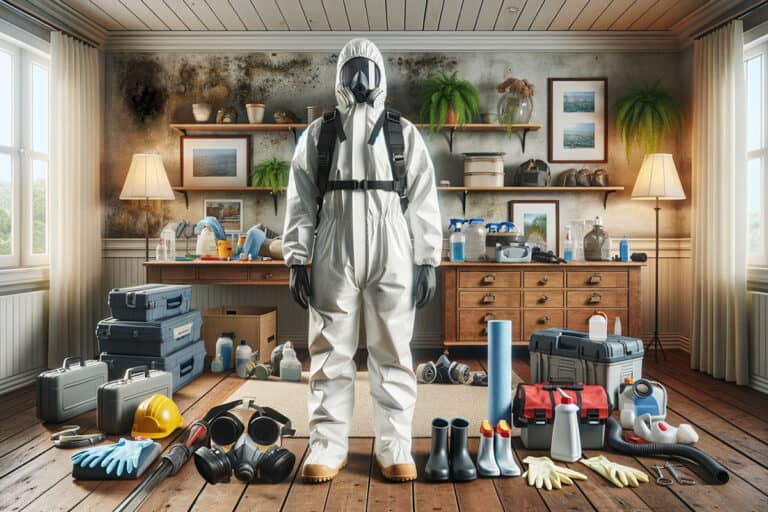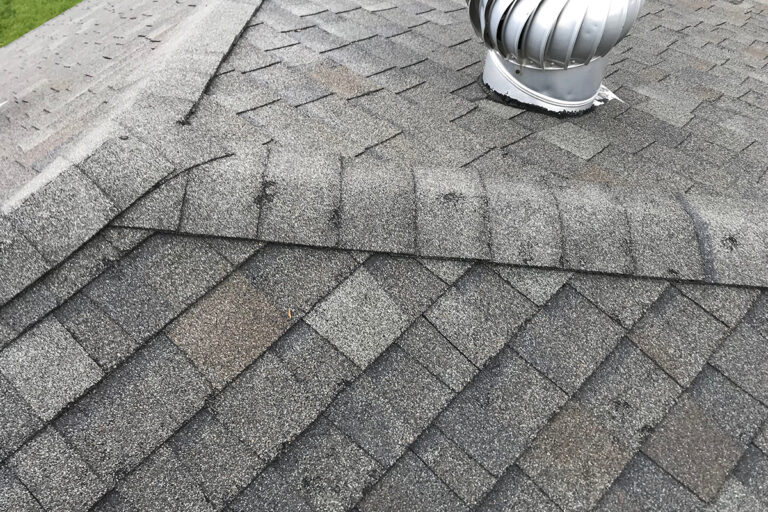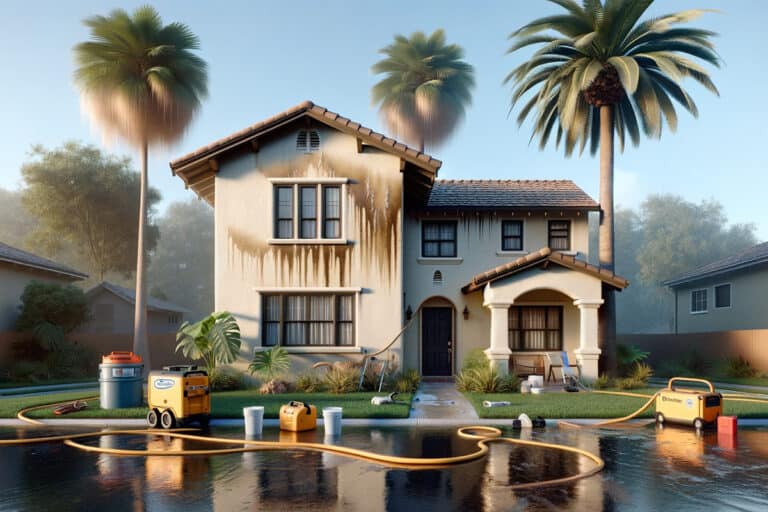Disclosure: I am compensated for purchases made through some links on this site. Click for details.
Water damage to a home can be a significant event, but with the right understanding of your home insurance policy, you can navigate the claims process effectively. Homeowners’ insurance typically covers water damage if it is sudden and accidental, such as from a burst pipe or a rainstorm. However, it’s crucial to know the specifics of your policy because some types of water damage, like flooding or gradual leaks, are often not covered unless you have additional riders.
Taking immediate action after discovering water damage is essential to limit further destruction and increase the chances of insurance coverage. This often involves stopping the source of the water, if possible, and documenting the damage thoroughly with photographs and detailed notes. After the initial steps, the claims filing process involves contacting your insurance company promptly and providing them with all the required information to assess the situation.
Key Takeaways
- Homeowners’ insurance may cover water damage depending on the cause.
- Immediate action and thorough documentation are crucial after water damage.
- Understanding the claims process is key to potential coverage and recovery.
Understanding Home Insurance Coverage
Navigating the nuances of home insurance in relation to water damage is crucial for homeowners. Understanding what is covered, the types of policies available, and the exclusions involved can help in the event of a claim.
Policy Types and Water Damage
Home insurance typically classifies water damage as a covered peril if it’s sudden and accidental, such as water from a burst pipe. Homeowners should be aware that dwelling coverage may repair the structure, while personal property coverage may replace damaged belongings. Loss of use coverage can also provide funds if the home is uninhabitable during repairs.
Coverage Limitations and Exclusions
Most policies exclude water damage that occurs over time, such as leaks due to lack of maintenance, recognizing it as preventable rather than accidental. Insurance companies often list specific water damage exclusions, such as sewer backup or groundwater seepage, unless additional coverage is purchased. Homeowners must read their policies carefully to understand these exclusions, as they play a critical role during the claims process.
Flood Insurance for Natural Disasters
Flood insurance is a separate policy that homeowners must purchase to cover water damage from natural disasters and weather-related flooding. It is vital to know that standard home insurance typically does not cover flooding from natural disasters. Homeowners living in flood-prone areas should consider this additional policy to secure protection against such natural disaster related peril.
Initial Steps After Water Damage
Upon discovering water damage, homeowners should prioritise safety, mitigate further damage, and begin the documentation process. These initial actions are critical in laying the groundwork for a successful insurance claim.
Safety and Damage Assessment
Safety should always be the first concern when dealing with water damage. Homeowners should shut off the main water supply to prevent additional flooding, especially in the case of a burst pipe. An inspection by a professional can identify the extent of the damage, ensuring that areas unsafe for habitation are avoided, reducing the risk of injury and mold development.
Water Mitigation and Temporary Repairs
Once the property is safe to enter, immediate measures to mitigate water damage should take place. This includes drying out affected areas, installing leak detectors if necessary, and making temporary repairs to prevent further damage. It is important for the homeowner to maintain proper maintenance of their property, as some insurance policies may not cover damages due to negligence.
Documentation and Evidence Collection
Thorough documentation is vital for insurance purposes. Homeowners should take clear photos and videos of all damaged areas and items. Receipts for any repair costs, including expenses for temporary repairs, should be kept as they may be reimbursable under the insurance policy. Collecting all this evidence in an organized manner will support the homeowner’s claim and potentially expedite the insurance payment process.
Filing an Insurance Claim
When a homeowner faces water damage, proper steps in filing an insurance claim are crucial for reimbursement. It is essential to understand the specifics of submitting the claim, coordinating with an insurance adjuster, and handling any potential claim denials and disputes.
Submitting the Claim
One begins by reviewing their homeowners insurance policy to determine the extent of water damage coverage and the deductible amounts. They must promptly notify their insurance company of the loss, as immediate reporting is often a policy requirement. Essential documentation to accompany the filing includes photos of the damage and a detailed inventory of affected items.
Working with an Insurance Adjuster
After filing a claim, an insurance adjuster is usually assigned to assess the extent of the damage and determine if it is a covered loss. Policyholders should be ready to provide the adjuster with all necessary documentation, which substantiates the claim. Throughout this process, maintaining clear and thorough communication with the adjuster will aid in an accurate assessment of the damage and help prevent delays.
Claim Denials and Disputes
If a claim is denied or the settlement offer is unsatisfactory, homeowners have the option to dispute the decision. This may involve providing additional evidence of the damage or demonstrating that there was no negligence involved in the maintenance of the property. Should the dispute not be resolved to the homeowner’s satisfaction, seeking external appraisal or legal consultation might become necessary.
Financial Considerations
When dealing with water damage, understanding the financial components of an insurance claim is vital. The homeowner’s focus should be on the intricacies of deductibles, out-of-pocket responsibilities, and the expectations of mortgage lenders. These factors influence the ultimate cost borne by the policyholder.
Understanding Deductibles
A deductible is the amount a homeowner agrees to pay out-of-pocket before the insurance coverage kicks in. The lower the deductible, the higher the premium, and vice versa. For instance, the Insurance Information Institute indicates that knowing one’s deductible is crucial in estimating the financial impact of a water damage claim.
Managing Out-of-Pocket Expenses
Out-of-pocket expenses are not limited to the deductible; they can also include costs not covered by the insurance policy. Homeowners should keep detailed records and receipts for all repair-related expenses. These should be well-documented to facilitate potential reimbursements or tax deductions.
Navigating Mortgage and Lender Requirements
Lenders often require homeowners to maintain an insurance policy that covers the structure of the home. If water damage affects the structural integrity or value of a property, the mortgage lender’s stipulations may influence the claims process. In such cases, the insurance payout might go directly to the lender to ensure repairs are completed.
Recovery and Restoration Process
After a water damage incident, homeowners must pursue a structured recovery and restoration process to ensure safety, prevent further damage, and secure insurance coverage for repairs.
Selecting a Contractor for Repairs
When choosing a contractor for water damage repairs, it is crucial that the homeowner opts for a licensed and insured professional with experience in water damage recovery. The homeowner should obtain multiple estimates to compare the repair costs, ensuring they align with what the insurance policy will cover. It’s important that the chosen contractor can clearly document the damages and repairs needed, as the insurance company will require detailed information.
Mold Remediation and Prevention
Mold remediation is a critical part of the water damage recovery process due to health risks associated with mold exposure. Homeowners should seek contractors who specialize in mold remediation to assess the extent of mold growth and recommend a course of action for removal and prevention. Efforts must focus on not just remedying current mold issues, but also ensuring that the home is protected from future mold problems by addressing the source of moisture.
Returning to Your Home
Before returning to their home, homeowners must ensure that all repairs are complete and all areas affected by water damage, such as from storms or plumbing failures, have been properly restored. Protection against potential theft or vandalism is key during the restoration phase, which might require heightened security measures. Finally, homeowners should confirm that the living environment is safe and that all risks associated with water damage, like structural issues or persistent moisture, have been fully resolved.
Preventing Future Water Damage
To minimize the likelihood of water damage and ensure that insurance companies are willing to cover future claims, homeowners should invest in regular maintenance and update their insurance policies. It’s essential to employ proactive measures and utilize technology for early detection of potential issues.
Regular Home Maintenance Tips
Homeowners should establish a routine maintenance schedule to check for signs of leaks or wear in pipes, roofing, and appliances. Proper maintenance includes cleaning gutters and downspouts, inspecting seals around windows and doors, and looking for foundation cracks that can lead to water intrusion. Emphasize examining areas prone to water damage regularly as improper maintenance can lead to insurance claim denials.
Installing Leak Detection Systems
Install leak detectors in high-risk areas like bathrooms, kitchens, and basements to alert homeowners early when leaks occur. These systems range from basic individual appliance sensors to whole-house monitoring solutions, which can integrate with home automation for immediate action, such as shutting off the water main. Leak detection can greatly reduce potential water damage and may be favorably considered by insurance companies when assessing policy coverage.
Reviewing and Updating Insurance Policies
Homeowners must thoroughly review their insurance policy to understand the specifics of their coverage. Policies differ on what types of water damage are covered, often excluding events that could have been prevented through proper maintenance. Regularly updating the insurance policy to reflect current needs can ensure adequate protection against unexpected water damage.
Conclusion
In conclusion, dealing with water damage requires a comprehensive approach, and understanding your insurance policy is paramount. Here are the key takeaways:
- Policy Coverage: Familiarize yourself with your home insurance policy to understand what types of water damage are covered, especially for sudden and accidental incidents, and consider additional coverage for events like natural disasters.
- Immediate Response: Prompt action is crucial in mitigating damage. This includes stopping the water source, if possible, and beginning the cleanup and documentation process immediately.
- Thorough Documentation: Document all damage meticulously with photos, videos, and detailed notes. This is essential for supporting your insurance claim.
- Regular Maintenance: Engage in routine home maintenance to prevent water damage. This includes inspecting plumbing, roofing, and appliancesDiscover key steps to maximize your insurance claim for water damage, including understanding policy coverage, immediate action, and thorough documentation. and can help in avoiding insurance claim denials for negligence.
- Proactive Measures: Install leak detection systems and regularly review and update your insurance policy to ensure it meets your current needs and covers potential water damage risks.
By following these steps, homeowners can effectively navigate the complexities of insurance claims and secure the best possible outcome for water damage recovery.






